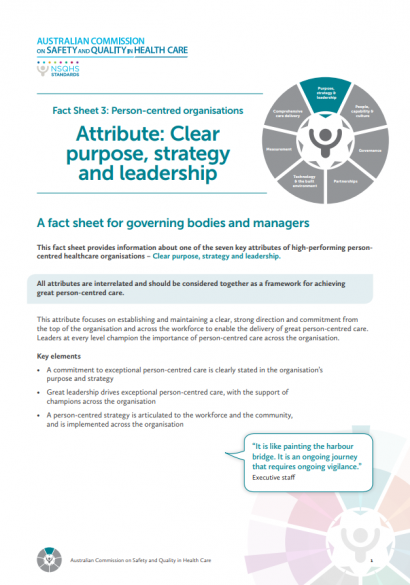The Commission has developed information for consumers on some key safety and quality issues, and health conditions.
The Australian Charter of Healthcare Rights describes the rights that you, or someone you care for, can expect when receiving health care.
Effective infection prevention and control practices reduce the risk of transmission of infections between patients, healthcare workers and others in the healthcare environment.
The end-of-life care audit toolkit is designed to help health service organisations to examine and improve the quality of their end-of-life care.
Clinical governance is central to providing the best outcomes for patients. It is the combination of culture, systems and processes that enables everyone in a health service to deliver care that is consistently high quality and improving.
It is the system by which boards, executives, clinical leaders and the workforce are accountable to patients and the community for providing high-quality care - care that is person-centred, safe, effective, accessible, and integrated in a system that is equitable, efficient and sustainable.
Through the cognitive impairment program, the Commission is supporting health service organisations to improve the safety and quality of health care for people with cognitive impairment.
Building effective and ongoing relationships with Aboriginal and Torres Strait Islander communities, organisations and groups that represent or service this population.
Providing a supportive environment and clear processes for the workforce to explore the cultural needs of Aboriginal and Torres Strait Islander patients can be a significant step towards the development of a safe and respectful organisation, where patients, their families and other community members can feel comfortable to engage with and receive care.
The user guide has been developed to support health service organisations implement the six Aboriginal and Torres Strait Islander health related actions.
The Commission has developed resources to assist health service organisations align their patient safety and quality improvement programs using the framework of the National Safety and Quality Health Service (NSQHS) Standards.
Organisation-wide systems are used to support and promote detection and recognition of acute deterioration, and the response to patients whose condition acutely deteriorates. These systems are consistent with the National Consensus Statement: Essential elements for recognising and responding to acute physiological deterioration, the National Consensus Statement: Essential elements for safe and high-quality end-of-life care, the National Consensus Statement: Essential elements for recognising and responding to deterioration in a person’s mental state, the National consensus statement: essential elements for safe and high-quality paediatric end-of-life care, and the Delirium Clinical Care Standard.

